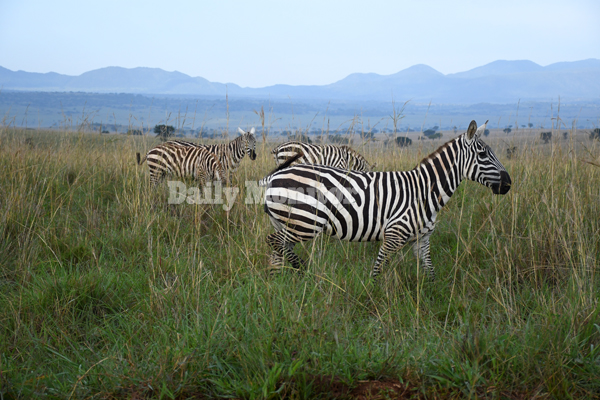Kidepo Valley National Park trip spiced by the wild African beauty

Some of the zebras in Kidepo Valley National Park. PHOTO | EDGAR R. BATTE
What you need to know:
- Bet you didn’t know. Kidepo Valley National Park is the third largest national park in Uganda after Murchison Falls and Queen Elizabeth national parks. It is 1, 442 square kilometres big.
- The park can be accessed using two routes. You can drive 710 kilometres using the eastern route through Kampala, Jinja, Mbale, Moroto, Kotido and Kaabong, 570 kilometres using the western route through Kampala, Karuma, Gulu, Kitgum and Karenga.
It is said that you cannot make a date with nature but Kidepo Valley National Park in the Karamoja region in Uganda seems to have connived with its multifaceted tourism and travel offerings to showcase its beauty to us.
It was worth our 13-hour drive to the park situated in the extreme north eastern side of Uganda. There was the rare sighting of a cheetah then elephants, lions, cape buffaloes, elands, Thomson Gazelle, Dikdik, Uganda kobs, warthogs, golden jackal, Mountain Reed-buk, bird species and some of the most beautiful and picturesque landscapes you will ever see. They roll on a horizon of Mount Morungole (2749 metres high) that provide a scenic view as seen from the low wild plains of green and golden savannah grasslands.
In the highland you will find the Ik monitory community. Some folks say they have captured their best sunsets in Kidepo.
In the name
By the way, the park gets its name from the Ngakarimojong local dialect, ‘Kidep’ which means to pick.
History has it that during dry spells, the park was a place from where water was collected.
The beauty in the wild
We are in the park for about a week and so far, the prized sighting of the cheetah is yet to sink in.
The wild male cat was resting in the grass at the early evening hour. It took moments to play, turning on its back and raising its legs as it faced skywards.
As it did so, it opened its mouth, involuntarily letting us see its sharp teeth that easily tear into flesh of its prey.
Its hide was clean and attractive. Our tour guide was the knowledgeable Phillip Akorongimoe who is the head guide in the national park. In his brief, he said cheetahs and leopards can be differentiated by the pattern of their spots (the rosettes).
Visually, the cheetah has a black tear mark running from its eyes, weighs less than 50 kilogrammes, is spotted and has a white tip on its tail. For an hour or so we spent admiring this jungle hunter, we observed its traits too that are similar to our domesticated pet cats. The sighting was a blessing for a good night.
Queens and kings of the jungle
On the next morning, our game drive led us to a carcass of dwarf buffalo we had seen the previous day.
We could not help but appreciate the natural course of the jungle where animals hunt and can be hunted. Later in the day, on return to the spot, the lion hunter was seated by the carcass, digging in with ease.
This was on our way to see three lions, two brothers and a lioness. They had been roaring the previous night which gave us reason to be excited because we had learnt that they love resting at the Kalabe Rock.
They initially put up a lazy display and then got playful, offering us awesome camera moments.
With the play, came some roars which complemented the quiet ambience where all we could hear were clicks of shutters. One of the tourists was a young girl who gleefully watched, seemingly overwhelmed at the sighting of lions.
Our team leader Abiaz Rwamwiri who is also a tour operator, made the early morning sighting and called us out of bed to see the sought-after kings and queens of the jungle.
Then word went round in the tour guides and drivers’ circles. In a few minutes, three more cars were at the rock with eager tourists who happily captured the prized attraction.
We moved on to Rionomoe rock where we had the opportunity to see two lionesses, a male and a cub. Akorongimoe told us that Kidepo has more than 50 lions.
More wild
We were able to learn that the national park is also home to the biggest number of cape buffaloes, about 15,000 cape buffaloes. The warthogs are comfortable in any park and Kidepo has some.
They easily blend in and interact with other wildlife. It is home to 80 mammals, 28 of these are endemic to the region and it is a birding paradise, with some 486 calling it home.
The trek
At some spots of the park, you will be awed at the sight of different shades. Just like Bwindi Impenetrable National Park that is home to the prized Mountain Gorilla which you will see after a sweat-breaking trekking excursion, getting to Kidepo is a full day’s journey that might leave you fatigued.
Experience
However, the expedition will calm your nerves and relax you at the sighting of the national park’s scenery. In terms of roads, be ready for some rough terrain that offers the real African safari experience, complete with rocking in your car seat.
The park has a number of hospitality facilities for accommodation. These range from luxury, midrange and budget.
If you are not into just wildlife, Kidepo offers the picturesque landscapes further beautified by the weather variations.





